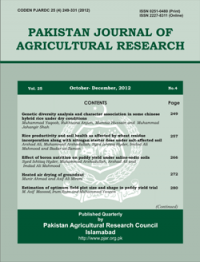PERFORMANCE EVALUATION OF DIFFERENT TILLAGE SYSTEMS IN A CLAY LOAM SOIL*
Ali Raza Shah**, Muhammad Saffar Mirjat**, Abdul Quadir Mughal***, Inayatullah Rajper** and Asif Ali Mirani****
ABSTRACT
Field experiments were conducted to assess the performance of different tillage systems in a clay loam soil. A completely randomized block design with four treatments i.e., conventional tillage (CT), minimum tillage (MT), zero tillage (ZT) and controlled traffic farming (CTF) was carried out to evaluate the performance of tillage systems. Results indicated that the soil pulverization was higher (P<0.05) under MT and lower under CT treatments while, it was nonsignificant between MT and CTF treatments. Similarly, soil volume disturbed and effective ploughing depth was maximum (P<0.05) under CT followed by MT, CTF and minimum under ZT. Similarly the operating speed was significantly higher (P<0.05) under CTF and lower under CT whereas, wheel slippage/travel reduction was significantly minimum (P<0.05) under CTF and maximum under CT. Significantly, higher field capacity was recorded under CTF and lower (P<0.05) under CT. The maximum fuel consumption (P<0.05) was recorded under CT while it was minimum under ZT. Almost similar trends were observed for all parameters in 2012 and 2013. The results suggested that the control traffic system was more efficient tillage system in terms of soil pulverization, operating speed, travel reduction and over all field capacity. While, zero tillage had minimum fuel consumption and conventional tillage had higher working depth hence, more soil volume was disturbed under this treatment.
To share on other social networks, click on any share button. What are these?







